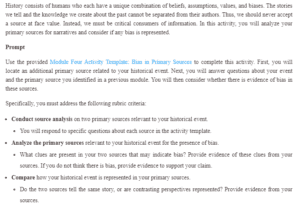Bias in Primary Sources
Source One
Manchikanti, L., Benyamin, R. M., & Hirsch, J. A. (2017). Evolution of US Health Care
Reform. Pain Physician, 20(3), 107-110.
Respond to the following questions:
- Who authored or created the primary source?
Manchikanti, L., Benyamin, R. M., & Hirsch, J. A
- What was the author’s position in society at the time the primary source was created?
Limited information about the authors’ position in society when the primary source was created is provided. However, there is a possibility that they were affiliated with the Massachusetts General Hospital and Harvard Medical School.
- When was the primary source created?
The source was created in 2017.
- Where was the primary source created, released, or publicized?
It was published in 2017.
- Who was the intended audience for the primary source?
The authors created the source for learners and other researchers who may be seeking the information.
- Why was the primary source created?
The source was created to provide a historical account of the evolution of healthcare in the United States. It highlights the key events that shaped the current healthcare system.
- Whose perspective(s) is presented in the source?
The article presents a nonpartisan perspective that is supported by sources. The events that are described are historical, and their information is publicly available.
Source Two
Deng, K. G. (2011). China and the birth of globalization in the 16th century – By Dennis O. Flynn and Arturo Giraldez. Economic History Review, 64(2), 669-713. doi:https://doi.org/10.1111/j.1468-0289.2010.00578_26.x
Respond to the following questions:
- Who authored or created the primary source?
Deng, K. G.
- What was the author’s or creator’s position in society at the time the primary source was created?
The author was affiliated with the London School of Economics.
- When was the primary source created?
It was created in 2011
- Where was the primary source created, released, or publicized?
Its first publication was in 2011
- Who was the intended audience for the primary source?
The source targets learners and researchers who seek to understand the globalization process.
- Why was the primary source created?
It was created to provide a narrative on globalization and the issues that surround it. It also discusses its origin and the role of external factors in the process.
- Whose perspective(s) is presented in the source?
The impartial perspective in the resource provides an objective analysis
Both Sources
Analyze the primary sources relevant to your historical event for the presence of bias.
The two sources are relevant and provide information objectively to the audience. Both sources provide detailed information. This information allows the readers to understand the issues that shaped or influenced the USA’s globalization and evolution of healthcare. The credibility of the sources is reliable because the authors provide references for the statements in the documents.
Compare how your historical event is represented in your primary sources.
The historical event is related to the two sources because they provide relevant information. The information sheds light on globalization and steps taken to influence it. The authors of both sources chronologically give the information. This makes it easy to follow through as a reader. In addition, the authors offer years for the various events. This eases the process of verifying the information that the authors provide. Further, this presentation also increases the validity of the documents.
ORDER A PLAGIARISM-FREE PAPER HERE
We’ll write everything from scratch
Question 
History consists of humans who each have a unique combination of beliefs, assumptions, values, and biases. The stories we tell and the knowledge we create about the past cannot be separated from their authors. Thus, we should never accept a source at face value. Instead, we must be critical consumers of information. In this activity, you will analyze your primary sources for narratives and consider if any bias is represented.

Bias in Primary Sources
Prompt
Use the provided Module Four Activity Template: Bias in Primary Sources to complete this activity. First, you will locate an additional primary source related to your historical event. Next, you will answer questions about your event and the primary source you identified in a previous module. You will then consider whether there is evidence of bias in these sources.
Specifically, it would be best if you addressed the following rubric criteria:
- Conduct source analysis on two primary sources relevant to your historical event.
- You will respond to specific questions about each source in the activity template.
- Analyze the primary sources relevant to your historical event for the presence of bias.
- What clues are present in your two sources that may indicate bias? Provide evidence of these clues from your sources. If you do not think there is bias, provide evidence to support your claim.
- Compare how your historical event is represented in your primary sources.
- Do the two sources tell the same story, or are contrasting perspectives represented? Provide evidence from your sources.